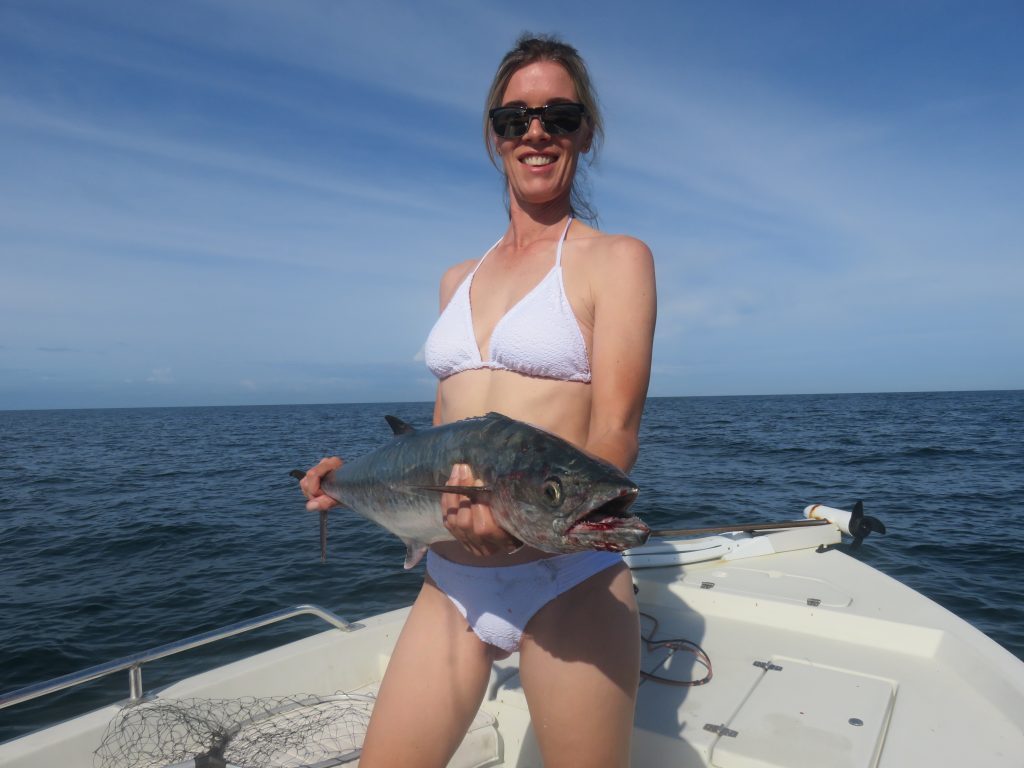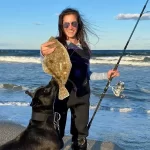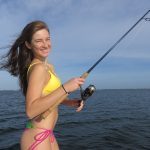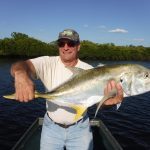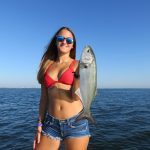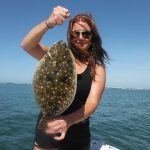Trolling Spoons with Planers – a Complete Guide!
This article will thoroughly cover trolling spoons with planers. Spoons are very effective fishing lures that catch a variety of fish. Planers are clever devices that get the lure down to the desired depth. It is primarily a saltwater fishing technique, though it is used in freshwater as well.
A planer is a device that digs down into the water, very much like a crankbait with a lip. The size of the planer with determine the depth, along with other factors. Larger planers dive deeper. The planer also “trips” when a fish is hooked. This results in the angler fighting the fish without the resistance of the planer pulling against the rod.
Planers are mostly used by anglers trolling in saltwater. The primary reason for this is the speed at which saltwater spoons are trolled. In freshwater fishing, anglers usually troll fairly slowly, a couple miles an hour at most. Downriggers and sinkers work fine in this application. In saltwater, trolling speeds of 7-8 miles per hour will produce! A downrigger ball would end up quite close to the surface at these speeds, as would trolling sinkers.
The spoons that anglers use when trolling spoons with planers are long and slender. This gives them a tight wiggle while allowing for higher trolling speeds. Wider spoons will wobble and roll. These specially designed trolling spoons are also quite light, thus the need for some device to get the lure down into the water column.

These spoons appeal to fast moving saltwater game fish. Anglers fishing closer to the beach will catch king and Spanish mackerel, false albacore, bluefish, striped bass, cobia, and more. Those fishing offshore will fool tuna, wahoo, mahi mahi, and even the occasional billfish! Capt Jim Klopfer is a fishing guide in Sarasota, Florida. He trolls spoons behind planers in the spring and fall. He shares his techniques in this article.
Planer design and sizes
A planer has a flat surface area which when angled downward causes the planer to dive. The main line is tied to a ring which slides on the planer. The planer will dive with the ring in the top position. When a fish strikes, the ring will slide to the front in an inline position, allowing the angler to fight the fish unencumbered by the drag of the planer. The depth is limited by the planer size. The lower the number, the smaller the planer and the shallower it with dive. The spoon will dive down to the same depth.

A long leader is used between the planer and the spoon. Twenty feet is a good all round length. It is important to have at least one swivel as spoons will cause line twist. Many anglers use a quality black snap swivel on each end of the leader. This facilitates easy changes of leader and spoon. The longer the leader, the more action the spoon has. Once the planer is reeled up to the rod tip, the fish much be hand-lined in the rest of the way, there is no way around this.
Trolling spoons with a number 1 planer

A number 1 planer is the smallest size. It will dive down 5-7 feet below the surface. While anglers can use a spinning rod, a light conventional rod and reel combination is a better choice. A 7′ medium action rod with 20 lb line works well. A 20′ length of 30-50 lb flourocarbon leader followed by a spoon is a good set up. One great thing about trolling spoons with planers is that large spoons can be used with smaller planers, and vice versa.
Click to shop Amazon for a #1 planer and rod and reel outfit
“Fishing Lido Key is a participant in the Amazon Associates Program, an affiliate advertising program designed to provide a means for sites to earn advertising fees by advertising and linking to Amazon. As an Amazon Associate I earn from qualifying purchases. ”
Trolling spoons with a number 2 planer

A number 2 planer is the next size up. It covers the water column in the 15′ to 18′ range. A heavier conventional rod and reel is required as the planer will put quite a drag on the rod. This is usually spooled with 40-50 lb line. A 50 lb to 80 lb leader followed by a spoon completes the rig. Most anglers troll a fairly large spoon with this outfit.
Click to shop Amazon for a #2 planer and rod and reel outfit
Trolling spoons with a number 3 planer
A number 3 planer is the next size up and is really the largest planer that can be practically trolled using a rod. It will put significant strain on a rod and reel. Anglers using this will need a stout conventional rod and reel in the 4/0 or so size. It will be spooled up with 80 lb line and will dive down to 25-30 feet or so.
Click to shop Amazon for a #3 planer and rod and reel outfit
Best trolling spoons
As mentioned earlier, saltwater trolling spoons are long and slender. They put out a tight wiggling action along with flash and vibration. The shape allows for fairly fast speeds. Anglers can certainly troll wider spoons as long as the speed is kept down a bit. As with all fishing, anglers should use a spoon that matches the local forage as well as the species being caught. Local tackle shops are usually a great source of information as to which spoons are producing in a particular area.

There are several manufacturers who offer trolling spoons to anglers. The leader in the industry, and Capt Jim’s favorite, is the Clark spoon. They come in a wide variety if sizes. Clark spoons have a red bead that attracts fish and they also have a kind of built in swivel, eliminating the need for a snap swivel on the spoon end of the leader. Silver is the most popular finish, though many anglers prefer the colored prism finishes for added flash.
Click to shop Amazon for Clark spoons

There are several other types of spoons that anglers can troll behind a planer. Some refer to these as “metals”, with Diamond jigs and Crippled Herring lures being prime examples. They work very well on mackerel and false albacore, especially behind a number 1 planer in clear water when fish are a bit fussy. When game fish are keyed in on tiny bait, this technique really shines.
Setting up the spread when trolling with spoons and planers

One of the most important aspects of trolling with spoons is setting up the trolling spread. It is pretty easy is a couple of things are taken into consideration. Anglers should put lines out of varying lengths and depths. This will limit tangles while covering more of the water column. Shallow lines are put out first and further back while deeper lines are put out last and closer to the boat.
Capt Jim’s “recipe” for trolling with spoons and planers
This is Capt Jim’s technique that he uses when trolling with spoons and planers. The first outfit used is a number 1 planer on a light conventional outfit. He uses a 20′ length of 40 lb leader and a size #2-#3 Clark spoon. This outfit will catch a lot of smaller fish such as Spanish mackerel and bluefish along with false albacore and other species. Capt Jim sets the planer and counts this rig out for 25 seconds, then engages the reel and puts it in a holder.

The number 2 planer is deployed next. Capt Jim uses a medium outfit with 20′ of 60 lb leader and a larger Clark or King spoon, usually with a little color. The planer is set and the planer counted out for 20 seconds, then locked up and placed in a rod holder on the opposite side from the number 1 planer.
The number 3 planer rod is put out last. This is a heavy rig that requires a bit of muscle, so novice anglers need to be careful. A larger spoon with 20′ of 100 lb leader is used. It is counted back 15 seconds and placed in a holder on the same side as the number 1 planer.
Trolling with spoons and planers
Now that the lines are set, the angler simply drives around at 4 to 7 miles per hour in search of fish. Top spots would be reefs and natural ledges as well as drop offs. Any surface activity should be investigated, making sure to skirt the edges as opposed to driving through the middle. Anglers using a number 3 planer need to watch the depth, particularly around reefs and wrecks.

There is no mistaking when a fish hits. The planer will “trip”. The rod will spring up, then start throbbing as the fish pulls. Larger fish will make a run, with the drag screaming; great fun! The boat can be slowed to idle to fight the fish, but it must be kept moving or the lines will tangle.
Once the planer is a foot or so from the rod tip, the fish is hand lined in the last twenty feet. Anglers need to be ready to let go if a larger fish is not quite done and makes a run. Obviously, this is best done with at least two anglers.
Trolling plugs with planers
Anglers can use other lures behind planers as well. For the most part, these are plugs, as jigs tend to roll at the higher speeds. Shallow diving plugs with small lips need to be used, otherwise they will trip the planer. Also, anglers should keep the speed to 5 miles per hour in most cases. Everything else is the same as far as depth and trolling techniques.

Trolling with large planers
Anglers can use planers larger than a number 3. However, these are normally not used with a rod. Instead, they are secured to the stern and when a fish is hooked it is hand lined in. Also, anglers can use a rod and a downrigger clip and use the planer much like a downrigger. This is a bit more complicated, but does produce for serious anglers fishing offshore.
Trolling with spoons and planers in freshwater

Freshwater anglers can enjoy success trolling spoons with planers as well. Experienced anglers are familiar with Dipsey Divers. These are lighter versions of the saltwater planers. They are made of plastic and have a clever design which uses a clip instead of the planer tripping. This allows for very easy changes in the depth that the lure runs.

Dipsey Diver planers also allow anglers to present baits off to the side as there is a setting for that as well. Anglers troll spoons and plugs for walleye, salmon, and a variety of trout species in northern lakes. The main difference is that these freshwater planers are made to be trolled at much slower speeds, otherwise the clips will release constantly. However, the premise is the same and they are very effective for presenting multiple lures at various depths.
In conclusion, this article on trolling spoons with planers will help anglers use this very effective fishing technique and catch more fish!
